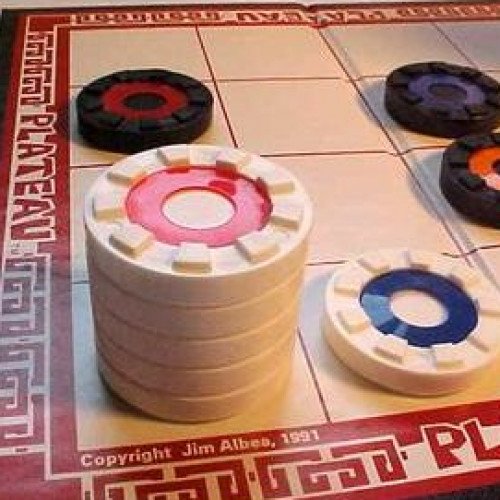PLATEAU VS TANTRIX

PLATEAU
Plateau is a two-player abstract strategy board game invented by Jim Albea. The game was developed over a two-year period culminating in its present form on May 12, 1986. The original name for the game was Pinnacle, but it was discovered that an older board/card game had that name, so around 1989 the name was changed to Plateau. From the 1980s through the 1990s Plateau was played at Science Fiction conventions mostly in the Southeastern United States. From the 1990s to the present, the game is played live at an online game site and via email. In 1997 a computer implementation of the game was created which facilitates email play and has a computer robot. Onboarding is adding one new piece to the play. This new piece can be placed anywhere that doesn't directly harm an opposing piece. For instance, you can onboard to any blank square or on top of any of your own pieces. The majority of Plateau moves are onboards. Instead of Onboarding or Moving, a player can choose to spend his turn exchanging prisoners. Prisoners are exchanged using the point values of the pieces. A simple value-for-value system is used. Since the pieces range in value from 1 point (for the mute) to 21 points (for the Ace) there are usually several combinations and options available for the players. The player initiating the exchange selects the pieces he wishes to exchange. These pieces will all add up to some point value. The responding player then has four options depending on the point values of the prisoners that he holds.
Statistics for this Xoptio

TANTRIX
Tantrix is a hexagonal tile-based abstract game invented by Mike McManaway from New Zealand. Each of the 56 different tiles in the set contains three lines, going from one edge of the tile to another. No two lines on a tile have the same colour. There are four colours in the set: red, yellow, blue, and green. No two tiles are identical, and each is individually numbered from 1 through 56. In the multiplayer version of the game, each player chooses a colour, so there are between two and four players. Each draws one tile from the bag, and the person who draws the highest number goes first. Each player then takes five more tiles from the bag, and places all six tiles face up in front of them. The first person plays one tile, usually with their colour on it. Play then rotates clockwise. After playing a tile, each player takes a replacement tile from the bag, so that they always have six in front of them. Tiles played must match the colour of the edges adjoining it. When three tiles surround an empty space so that it is effectively half covered this is called a forced space. If the person whose turn it is has a tile that fills that space they must play it. The player repeats this process until there are no more forced spaces that they can fill, at which stage they make a free move, where they can play any tile as long as they don't breach the three restriction rules given below. Once they have had a free move, they must then fill any more forced spaces that they can. Thus one player's turn can consist of several moves.